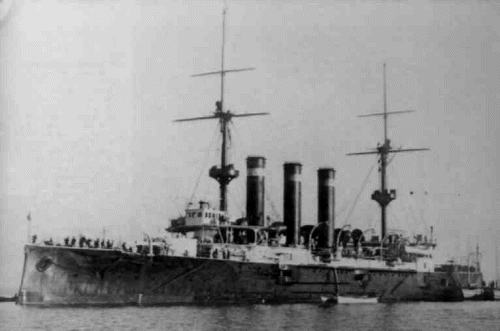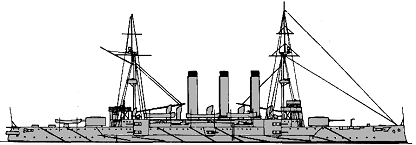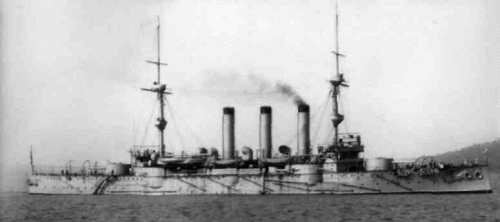
NAVYPEDIA
 Support the project with paypal
Support the project with paypal
Photo

Izumo 1900
Ships
| Name | No | Yard No | Builder | Laid down | Launched | Comp | Fate |
|---|---|---|---|---|---|---|---|
| 出雲 [Idzumo] | 681 | Armstrong, Elswick, UK | 5/1898 | 19.9.1899 | 25.9.1900 | sunk 28.7.1945 | |
| 磐手 [Iwate] | 689 | Armstrong, Elswick, UK | 11/1898 | 29.3.1900 | 18.3.1901 | sunk 25.7.1945 |
Technical data
| Displacement normal, t | 9750 |
|---|---|
| Displacement full, t | 10300 |
| Length, m | 121.9 pp 132.3 oa |
| Breadth, m | 20.9 |
| Draught, m | 7.37 |
| No of shafts | 2 |
| Machinery | 2 VTE, 24 Belleville boilers |
| Power, h. p. | 14500 |
| Max speed, kts | 20.8 |
| Fuel, t | Idzumo: coal 1402 Iwate: coal 1412 |
| Endurance, nm(kts) | 7000(10) |
| Armour, mm | belt: 178 - 89, bulkheads: 152, upper belt: 127, barbettes: 152 - 102, turrets: 152, casemates: 152, deck: 63 - 51, CT: 356 - 76 |
| Armament | 2 x 2 - 203/45 Armstrong U, 14 x 1 - 152/40 Armstrong Z, 12 x 1 - 76/40 Armstrong N, 8 x 1 - 47/30 21/2pdr Hotchkiss Mk I, 4 - 450 TT (beam) |
| Complement | 672 |
Standard scale images

Idzumo 1900
Graphics
Project history
The design, by Sir Philip Watts, was practically the same as the earlier Asama, but improvements made in machinery design enabled the builders to equip the new class with 24 of the much lighter and more efficient Belleville boilers instead of the 12 single-ended cylindrical boilers of the Asama. Altogether the new machinery led to a saving in weight of some 300t. Armament and protection were also very similar, except that the armour in the new class was of Krupp CS in place of the Harvey NS used in the Asama. The total number of watertight compartments was 166, 30 of which were in the double bottom.
Ship protection
Main 178mm belt had 83.8m length (between barbettes) and 2.1m height, closed by 152mm bulkheads abreast barbettes. Its thickness was 89mm outside barbettes. There was upper 2.1m high 127mm belt (53.3m long on Idzumo and 51.2m on Iwate). 51mm deck was connected with lower edge of main belt by 63mm slopes. It has turtleback form and 63-51mm thickness outside barbettes. CT had 356mm sides and 76mm roof. All 8`` and 6`` guns (but 4 6`` guns with 51mm protection) had 152mm protection.
Modernizations
1924: - 4 x 1 - 76/40, 4 x 1 - 47/30, 2 - 450 TT; + 1 x 1 - 76/40 3-shiki
1931, Iwate: boilers were replaced by 6 Yarrow (oil- and coal-burning), engine power decreased to 7000hp and maximal speed to 16kts; - 6 x 1 - 152/40, 4 x 1 - 76/40, 4 x 1 - 47/30, 2 - 450 TT
1935, Idzumo: boilers were replaced by 6 Kampon (oil- and coal-burning), engine power decreased to 7000hp and maximal speed to 16kts; - 6 x 1 - 152/40, 4 x 1 - 76/40, 4 x 1 - 47/30, 2 - 450 TT
1937 - 1939, Idzumo: - 4 x 1 - 76/40
1937 - 1939, Iwate: - 4 x 1 - 76/40; + 2 x 1 - 76/40 3-shiki
1945, Idzumo: - 2 x 2 - 203/45, 4 x 1 - 152/40; + 2 x 2 - 127/40 89-shiki, 4 x 2 - 25/60 96-shiki, 6 x 1 - 25/60 96-shiki
1945, Iwate: - 2 x 2 - 203/45, 4 x 1 - 152/40; + 2 x 2 - 127/40 89-shiki, 1 x 3 - 25/60 96-shiki, 2 x 2 - 25/60 96-shiki, 2 x 1 - 25/60 96-shiki, 2 x 1 - 13.2/76
Naval service
Both actively participated in the Russian-Japanese war. In September, 1921 they were reclassified to 1st class coast defence ships. Idzumo in 1932-1942 was a leader of the Japanese so-called Chinese fleet; then for a short while reclassified to 1st class cruiser, and in 1943 to TS. Iwate actually served as TS since 1923 though in 1942 also has been formally enlisted as 1st class cruiser. Both were sunk in July, 1945 at shallow water in Kure by American aircraft, salvaged after war and handed over on demolition in 1947.
Many thanks to Wolfgang Stöhr for additional information on this page.
 HOME
HOME FIGHTING SHIPS OF THE WORLD
FIGHTING SHIPS OF THE WORLD JAPAN
JAPAN CRUISERS
CRUISERS IDZUMO armoured cruisers (1900 - 1901)
IDZUMO armoured cruisers (1900 - 1901)

